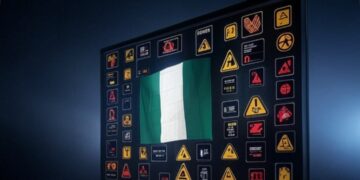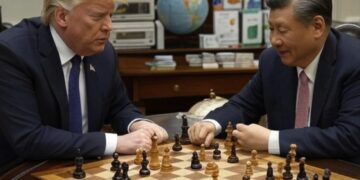In a recent Truth Social post on April 6, 2025, former President Donald Trump touted tariffs as a cure for America’s trade deficits with China, the European Union, and other nations, claiming they’ve already funneled “tens of billions of dollars” into the U.S. economy. Calling them a “beautiful thing,” Trump argued that trade surpluses with these countries ballooned under President Joe Biden and promised a swift reversal through aggressive tariff policies. But is this economic vision as rosy as it sounds? Critics, including economic analyst Ali Mugiwara Kenshin, argue that the reality of tariffs is far more complex—and potentially damaging—than the rhetoric suggests. As stakeholders in America’s economic future, it’s worth unpacking the issue.
The Trade Deficit Dilemma
The U.S. has long run trade deficits, importing more goods than it exports. In 2022, under Biden, the overall trade deficit hit a record $951 billion, fueled by post-COVID demand, a strong dollar, and supply chain recovery. Trump’s post highlights surpluses with specific countries as a problem to fix, but deficits aren’t inherently bad. They often reflect consumer choice and economic strength—Americans import more because they can afford to. Meanwhile, U.S. companies dominate high-value services like tech, finance, and intellectual property, which don’t appear in traditional goods-based trade figures. Focusing solely on physical goods, as Kenshin notes, “skews the narrative.”
Tariffs: Who Really Pays?
Trump frames tariffs as revenue extracted from foreign nations, but the mechanics tell a different story. Tariffs are taxes levied on U.S. importers—American businesses—not foreign governments. These companies often pass the costs onto consumers, effectively making tariffs a domestic tax. Since Trump’s first tariff wave in 2018, prices for steel, washing machines, and electronics spiked. Studies estimate those tariffs shaved 0.2% off GDP growth and cost 142,000 jobs in supply chain-dependent industries by 2019. Small businesses and farmers, reliant on affordable inputs, bore much of the brunt.
Globally, the story flips: other countries tariff U.S. goods heavily too. Europe slaps a 25% duty on American cars; China hits U.S. agricultural exports with retaliatory levies. Like in the U.S., those costs fall on their importers and, ultimately, their consumers. Some nations, however, rely less on imports, producing domestically to offset the hit. Others use tariffs strategically to boost local industries byлиз
The Economic Reality Check
Trump’s promise to “reverse [deficits] QUICKLY” via tariffs sounds decisive, but macroeconomics doesn’t bend to political will overnight. The U.S. economy has evolved—manufacturing, once a jobs engine, now employs fewer people (about 12.8 million in 2025) than it did decades ago, largely due to automation, not trade. The service sector—tech, healthcare, finance—drives growth, offering higher-paying, more stable jobs. Forcing a manufacturing revival through tariffs ignores this shift and risks destabilizing industries tied to global supply chains. As of March 2025, unemployment sits at a near-record low of 3.9%. Why upend a humming economy for a nostalgic vision?
Tariffs also ripple outward. They raise costs for U.S. businesses, making exports less competitive, and fuel inflation that erodes consumer confidence. History looms large here: the Smoot-Hawley Act of 1930, a tariff-heavy response to economic woes, deepened the Great Depression by choking global trade. Today’s interconnected markets amplify such risks.
The Other Side: Why Tariffs Persist
Proponents argue tariffs protect domestic industries and force fairer trade. China, for instance, subsidizes its manufacturers and restricts U.S. firms’ market access—grievances with merit. Tariffs can generate revenue (about $80 billion annually in recent years) and pressure adversaries into negotiations. Yet, the flip side persists: other countries retaliate, as China did in 2018 with soybean tariffs that hammered U.S. farmers. And nations with robust domestic production—like Germany or Japan—weather import taxes better than the U.S., which leans on global inputs.
A Balanced View for Stakeholders
Tariffs aren’t a silver bullet. They’re a blunt tool—sometimes useful, often disruptive. For every dollar they bring in, they raise costs and spark uncertainty. Stakeholders—business leaders, investors, policymakers—must weigh the allure of “beautiful” protectionism against data-driven risks: job losses, inflation, and market instability. The U.S. thrives on innovation and adaptability, not isolation. As global trends, not presidential decrees, shape trade balances, the question remains: do tariffs build a stronger future, or just a louder echo of the past?





































